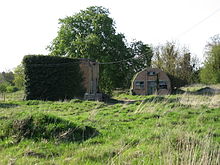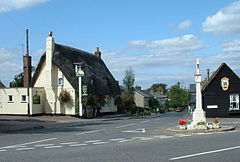|
Fowlmere
Fowlmere is one of the southernmost villages in Cambridgeshire, England. The population of the civil parish at the 2011 Census was 1,206.[1] It is very close to the Imperial War Museum Duxford, and 9 miles (14 km) southwest of the city of Cambridge. HistoryThe village has an ancient landmark called the ‘Round Moat’, which is the remains of an early Saxon settlement dating from around the ninth century.[2]
The Census Records from 1841 to 1891 can be found in the Cambridge Record Office. In addition, the 1851 Census for Fowlmere is available in full transcript form, on microfiche, from the Cambridgeshire Family History Society Bookstall. 
The village was struck by an F1/T2 tornado on 23 November 1981, as part of the record-breaking nationwide tornado outbreak on that day.[3] Village lifeFowlmere has one pub, The Chequers, which has operated since the 16th Century. It served as a coaching inn for travellers going into and from Cambridge and was even used as coffin storage for those travelling with bodies. It was notably mentioned in the diary of Samuel Pepys, which is regarded as an important historical English diary. Nowadays, the pub serves as a local bar and restaurant that takes in patrons from many nearby villages.[4] Fowlmere has no general convenience shop, but does have a small business park that houses several business. near the Village Hall. They are regularly used by locals for recreation and are maintained by the local council. SchoolFowlmere has one school, Fowlmere Primary School, which educates around 100 students a year. It is an extension of an old school building that has been used since its founding in 1861. It teaches pupils aged 4–11 (years reception to 6) and attracts pupils from Fowlmere, Thriplow and nearby Great Chishill, which does not have a Primary school of its own. The site lies opposite 'The Butts' which is a field and neighbourhood at the edge of the village. The school forms a large part of the community, as most of the children in the small village grow up around it.[5] Airfield Fowlmere Airfield opened in late-1916 as an emergency landing ground for 75 (Home Defence) Squadron of the Royal Flying Corps, who had their HQ in Bedford and dispersed their three flights to Yelling (St Neots), Old Weston (Thrapston) and Therfield (Baldock) on anti-Zeppelin duties. Its purpose was to receive aircraft lost, out of fuel or with engine troubles and was staffed with a minimum number of personnel whose prime task was to light flares to aid pilots in finding the site. It closed down after WW1. As RAF Fowlmere, near the edge of the village, it was the location for the RAF Station and transferred to the United States Army Air Force (USAAF) for use by their 339th Fighter Group during World War II. The Group flew its first combat mission on 30 April 1944, and its last on 21 April 1945. The airfield now provides pilots with self-fly Piper aircraft and servicing, as well as PPL training. Natural history The Fowlmere nature reserve (maintained by the RSPB) is situated west of the village, between it and the village of Melbourn. With 2.4 kilometres (1 mi) of nature trails, it attracts many visitors. Several special birds are seen there, including: kingfishers, water rails, and grasshopper warblers. Fowlmere, along with several other Cambridgeshire villages, lays claim to a sighting of the infamous Fen Tiger, a supposed wild big cat.[6] See alsoReferences
External linksWikimedia Commons has media related to Fowlmere. |
||||||||||||||||||||||||
Portal di Ensiklopedia Dunia

